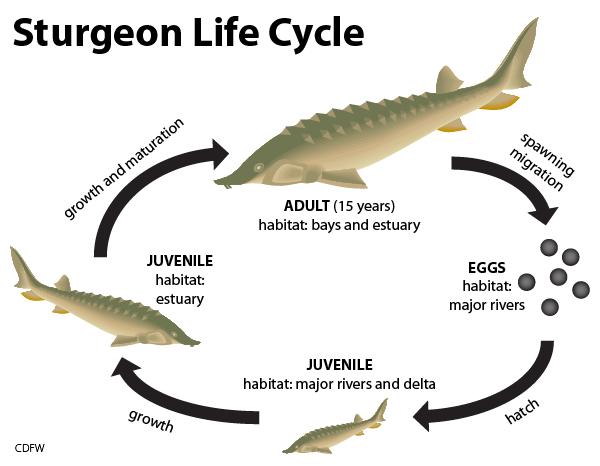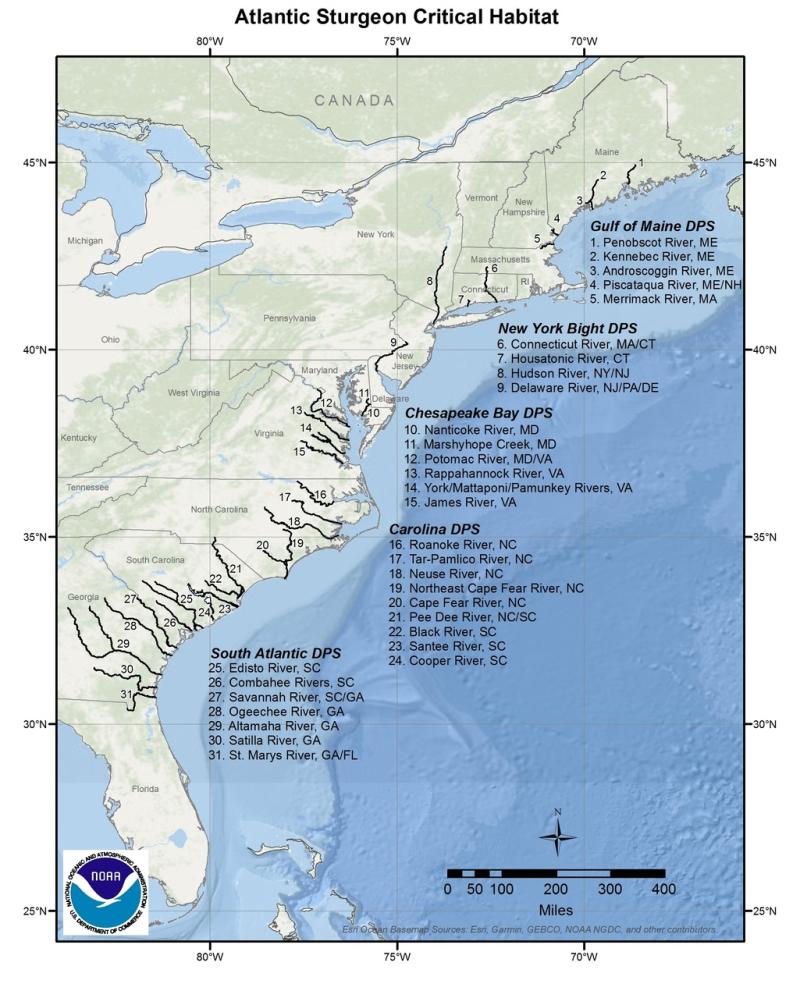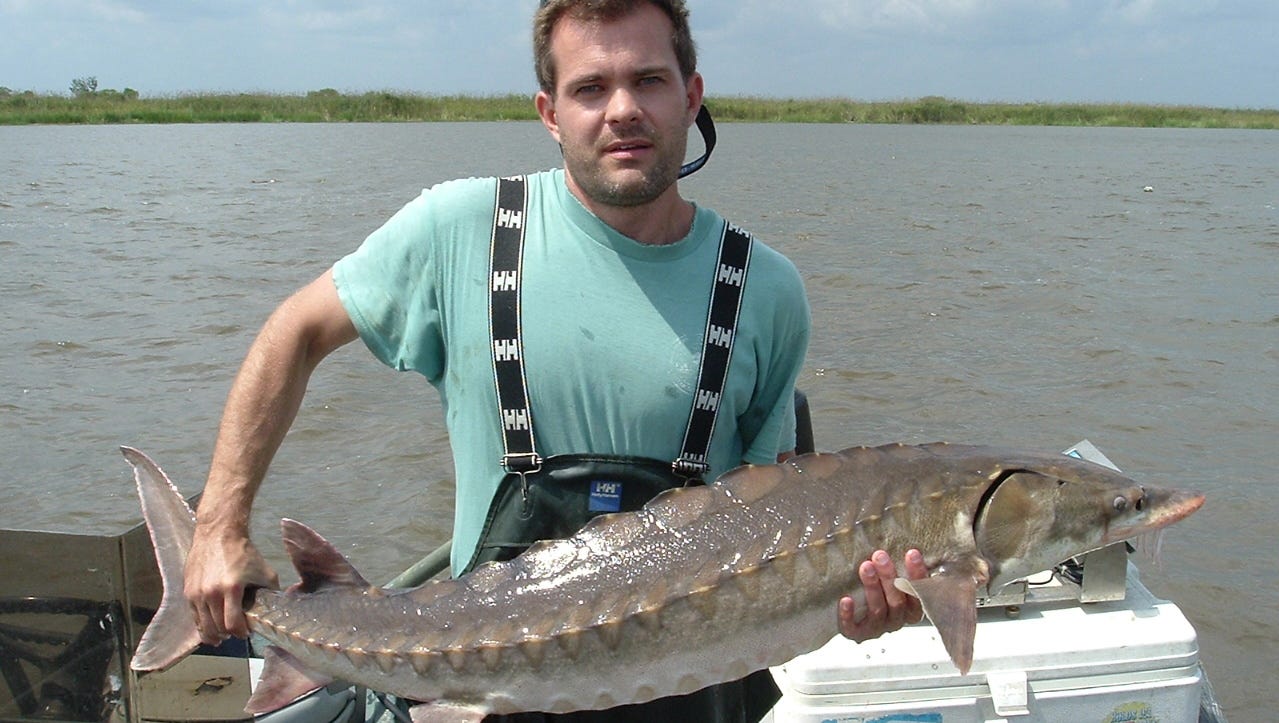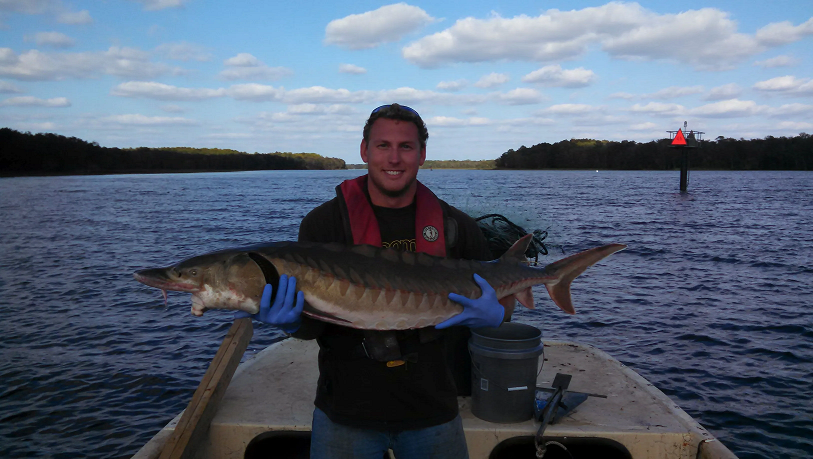Researchers say that Atlantic Sturgeons are the most primitive of the bony fishes alive today and their relatives date back more than 350 million years. The Sturgeons swimming today are quite similar to those that swam alongside the dinosaurs! Can you fish for Atlantic Sturgeon?
No, the Atlantic States Marine Fisheries Commission’s Fishery Management Plan for Atlantic Sturgeon calls for a coastwide moratorium until 2038, in order to build up 20-year classes of spawning females & if caught by accident, they must be immediately released to ensure the best probability of survival.
Subtle changes in temperature and water quality have affected Atlantic Sturgeon in the wild water contamination along with overfishing, and damming of rivers affecting feeding and breeding grounds so less caviar and more demand over the years has led to very high prices.
Can You Fish for Atlantic Sturgeon

Atlantic sturgeon species are also called Freshwater Sturgeon because they live part of their lives in freshwater rivers and coastal waters from Canada to Florida.
They are one of the biggest fish in the world and are considered an endangered species. The Sturgeon is considered to be a living fossil because it has barely changed in over 200 million years of its existence.
It has not evolved much because of how well it is adapted to its environment and habitat. Hatched in the freshwater of rivers, Atlantic sturgeon will migrate out to sea as sub-adults, and return to their birthplace to spawn, or lay eggs, when they reach adulthood.
Unlike most fish that are covered with scales, the Atlantic sturgeon is easy to identify by the five lateral rows of bony plates known as scutes that run along its body to help protect it and a snout with four slender, soft tissue projections called barbels in front of its mouth help it to find food.
In addition, the tail is like a shark’s where one side, or lobe, is larger than the other. Atlantic Sturgeons have a cartilaginous skeleton and an ancient appearance.
Local sturgeons normally spend more of their lives in estuarine or marine environments, where they are less susceptible to quicker habitat changes, and return to freshwater only at some points to spawn.
All of these features give the fish its unique look. The prehistoric-looking Atlantic sturgeon are slow-growing and late-maturing and have been recorded to reach up to 14 feet in length and 800 lbs in weight and up to 100 years of age.
Where Do Sturgeon Spawn
 Atlantic surgeons are Andromous which means that they spend most of their life in saltwater live but migrate to freshwater habitats to spawn.
Atlantic surgeons are Andromous which means that they spend most of their life in saltwater live but migrate to freshwater habitats to spawn.
Atlantic sturgeon spawning intervals in the wild range from 1 to 5 years for males and 2 to 5 years for females, with males returning almost every year and females usually returning every other year or every third year.
Atlantic sturgeon will ascend tributaries to spawn in tidal freshwater in May or June when temperatures reach approximately 64 o F. Males mature in 10-20 years when they are approximately 5 feet and 90 pounds. Females mature in 15-30 years at 6 feet and 160 pounds.
Spawning runs of Atlantic sturgeon are still not completely understood. In rivers from Georgia to the Chesapeake Bay, scientists have confirmed that adult Atlantic Sturgeon spawns during the late summer and fall.
After spawning, males in northern rivers may remain in the river or lower estuary until the fall while the females typically exit the rivers within 4 to 6 weeks after spawning.
The females lay tens of thousands of eggs at a time, and the males release their sperm to fertilize them. It takes about a week for the eggs of most species to hatch.
The young receive no parental care. It takes about 15 – 20 years for the fish to reach sexual maturity in the wild.
What Do Sturgeon Eat
In the wild, sturgeon considered bottom feeders are opportunistic in nature. This means that their mouth is facing the river or sea floor and they will eat just about anything that they can find on the floor of a river or lake.
This includes other fish, crustaceans, mollusks, insects, plant matter, and even small mammals or reptiles if they can catch them. Sturgeons have been known to eat just about anything that they can fit in their mouths. This diet helps to keep them healthy and provides them with all of the nutrients that they need.
Similar to stingrays, these fish’s mouths sit well underneath their head. Because of this, they primarily forage along the bottom when searching for prey. When this fish finds a potential meal, it does not bite at it. Instead, it creates suction with its mouth.
Are Sturgeon Endangered
For 4000 years the Atlantic Sturgeon has been used as food for indigenous people and is even credited as the main staple for Jamestown settlers in 1607. The Atlantic Sturgeon fishery in the Hudson Valley was so productive that this fish was once referred to as “Albany beef” as they were a common source of protein throughout the Hudson Valley.
 These days though the Sturgeon is in trouble mostly due to habitat loss from river dredging and approaching salt lines that hurt spawning areas along with overfishing for its desired meat and eggs which are called Caviar. They have become added to the endangered species list here in America.
These days though the Sturgeon is in trouble mostly due to habitat loss from river dredging and approaching salt lines that hurt spawning areas along with overfishing for its desired meat and eggs which are called Caviar. They have become added to the endangered species list here in America.
Unfortunately for the Atlantic Sturgeon, their breeding process is quite slow. From the time of hatching, it takes between 15 and 20 years for a fish to begin reproducing. This means that, when humans kill off the adults in their environment, it takes many years for the younger fish to reach breeding age and replenish their population.
Because of this, there is a hold on harvesting these fish while Scientists are using tagging programs and following Atlantic Sturgeon as they complete their migratory paths during their lifespan. Fish are measured and weighed by a Biologist who gets a good idea of how small or large the population of this great fish has been around since the dinosaurs.
Preserving and managing the Atlantic Sturgeon is the whole idea and most people believe their effort should pay off for the future of the Atlantic Sturgeon and its place on rivers of the US eastern seaboard. New York implemented a harvest moratorium in 1996. New Jersey followed with a zero quota in the same year. In 1998, the ASMFC (The Atlantic States Marine Fisheries Commission) adopted Amendment 1 to the Interstate Fishery Management Plan for Atlantic Sturgeon.

Because the population had been severely overfished, the Commission’s Fishery Management Plan for Atlantic Sturgeon calls for a coastwide moratorium through at least 2038, in order to build up 20-year classes of spawning females. Several facilities culture Atlantic sturgeon for research purposes.
Atlantic and Shortnose Sturgeons are protected species. If you accidentally catch a sturgeon:
- Keep the Sturgeon in the water and remove the hooks
- If the hooks are too deep, cut the line
- If you need to remove the Sturgeon from the water in order to do this, always use wet hands or a wet rag to support the belly.
- Always support the fish in the water until it is able to swim away on its own
The Atlantic and Shortnose Sturgeon are still very vulnerable to a number of threats like bycatch, climate change, environmental events, and a variety of human activities that result in population impacts.
Atlantic sturgeons can be struck by the blades of a propeller as the many boats using the rivers are passing, or struck by the boat itself. The risk of injury and mortality can be high in areas with high ship traffic, including the Hudson, Delaware, and James Rivers.
Scientists are using tagging techniques to learn about the migration patterns of Atlantic sturgeon and identify important juvenile habitats. Dart, passive integrated transponder (PIT), radio, satellite, pop-off, and acoustic tags are commonly used types of tags to keep track of Atlantic Sturgeon on the move. It’s illegal to fish for Atlantic Sturgeon.
No fishing is allowed for Atlantic sturgeon or Shortnose sturgeon in Delaware waters. No harvest of sturgeon is allowed, considered a homestream-spawne.
Atlantic sturgeon are an example of an anadromous fish they spend most of their life in the sea; these fish can then swim to a river mouth and back upstream to the freshwaters where they were born in order to breed. Then the cycle starts over. South Atlantic Sturgeon Critical Habitat NOAA fisheries with large sturgeon populations run from Maine to South Carolina.
These Atlantic Sturgeon will mature in the section of watershed, bay, and saltwater oceans and return to the river of their birth to swim upstream and breed. The young will remain in the river, often for several months after birth, before venturing out into the open sea.
No fishing is allowed for Atlantic sturgeon or Shortnose sturgeon in Delaware waters. Atlantic Sturgeon and Shortnose Sturgeon are considered home stream-spawner endangered species fish.
The Hudson River and James River the Chesapeake Bay are considered NOAA fisheries where females lay eggs. Atlantic (DPS) Distinct Population Segment is shown on this map for Atlantic Sturgeon.
Fish scales act like armor protecting fish from scrapes on rocks & branches protecting the fish from injury, & shielding fish from predators. Scales provide defense against parasites. They make fish more aerodynamic & help them move through the water faster up, down, or …………………………………………………………………………………. Read more
What Fish Have the Sharpest Teeth?
Freshwater
Alligator Gar-2 rows of the razor-sharp teeth
Tiger Muskies -100’s brush-like teeth & large canines
Walley-30-40 canine teeth- front of their mouth
Saltwater
Bluefish- vicious-razor-sharp teeth
Pacific lingcod-18 large & 555 tiny needle-sharp teeth
Barracuda- monster fangs with 140 to 220 teeth .…………………………………………………………………………………….. Read more
JimGalloway Author/Editor

References: NOAA Atlantic Sturgeon
Dept. of Environmental Conservation-Atlantic Sturgeon
